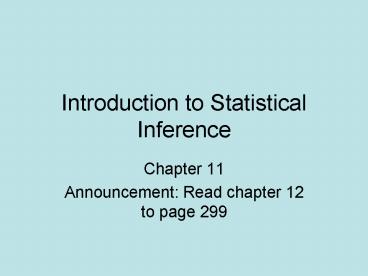Introduction to Statistical Inference - PowerPoint PPT Presentation
Title:
Introduction to Statistical Inference
Description:
A subset of the population. Characteristics are called statistics. In most cases we cannot study all the members of a population. Inferential Statistics ... – PowerPoint PPT presentation
Number of Views:42
Avg rating:3.0/5.0
Title: Introduction to Statistical Inference
1
Introduction to Statistical Inference
- Chapter 11
- Announcement Read chapter 12 to page 299
2
Populations vs. Samples
- Population
- The complete set of individuals
- Characteristics are called parameters
- Sample
- A subset of the population
- Characteristics are called statistics.
- In most cases we cannot study all the members of
a population
3
(No Transcript)
4
Inferential Statistics
- Statistical Inference
- A series of procedures in which the data obtained
from samples are used to make statements about
some broader set of circumstances.
5
Two different types of procedures
- Estimating population parameters
- Point estimation
- Using a sample statistic to estimate a population
parameter - Interval estimation
- Estimation of the amount of variability in a
sample statistic when many samples are repeatedly
taken from a population. - Hypothesis testing
- The comparison of sample results with a known or
hypothesized population parameter
6
These procedures share a fundamental concept
- Sampling distribution
- A theoretical distribution of the possible values
of samples statistics if an infinite number of
same-sized samples were taken from a population.
7
Example of the sampling distribution of a
discrete variable
8
Continuous Distributions
- Interval or ratio level data
- Weight, height, achievement, etc.
- JellyBlubbers!!!
9
Histogram of the Jellyblubber population
10
Repeated sampling of the Jellyblubber population
(n 3)
11
Repeated sampling of the Jellyblubber population
(n 5)
12
Repeated sampling of the Jellyblubber population
(n 10)
13
Repeated sampling of the Jellyblubber population
(n 40)
14
For more on this concept
- Visit
- http//www.ruf.rice.edu/lane/stat_sim/sampling_di
st/index.html
15
Central Limit Theorem
- Proposition 1
- The mean of the sampling distribution will equal
the mean of the population. - Proposition 2
- The sampling distribution of means will be
approximately normal regardless of the shape of
the population. - Proposition 3
- The standard deviation (standard error) equals
the standard deviation of the population divided
by the square root of the sample size. (see 11.5
in text)
16
Application of the sampling distribution
- Sampling error
- The difference between the sample mean and the
population mean. - Assumed to be due to random error.
- From the jellyblubber experience we know that a
sampling distribution of means will be randomly
distributed with
17
Standard Error of the Mean and Confidence
Intervals
- We can estimate how much variability there is
among potential sample means by calculating the
standard error of the mean.
18
Confidence Intervals
- With our Jellyblubbers
- One random sample (n 3)
- Mean 9
- Therefore
- 68 CI 9 or 1(3.54)
- 95 CI 9 or 1.96(3.54)
- 99 CI 9 or 2.58(3.54)
19
Confidence Intervals
- With our Jellyblubbers
- One random sample (n 30)
- Mean 8.90
- Therefore
- 68 CI 8.90 or 1(1.11)
- 95 CI 8.90 or 1.96(1.11)
- 99 CI 8.90 or 2.58(1.11)
20
Hypothesis Testing (see handout)
- State the research question.
- State the statistical hypothesis.
- Set decision rule.
- Calculate the test statistic.
- Decide if result is significant.
- Interpret result as it relates to your research
question.































